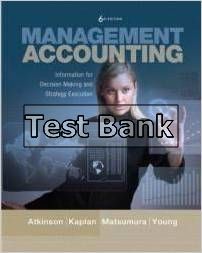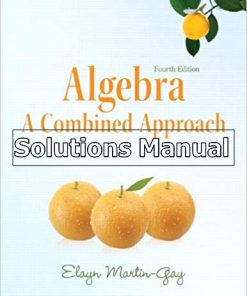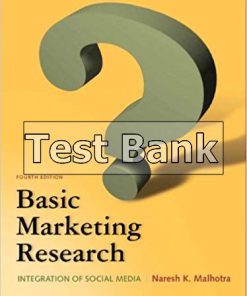Management Accounting 4th Edition Seal Test Bank
You may also like
-
$26.50
$50.00 -
$26.50
$50.00
Management Accounting 4th Edition Seal Test Bank

Product details:
- ISBN-10 : 9780077121648
- ISBN-13 : 978-0077121648
- Author: Will Seal
The new fourth edition of Management Accounting by Professor Will Seal offers comprehensive coverage as well as a balance between the technical and conceptual approaches to management accounting. Retaining its student friendly writing style and practical approach, it is the ideal text for students studying management accounting across a variety of levels, from introductory through to advanced levels.
Table contents:
Part 1 Management accounting and cost management 1
Chapter 1 The role of accounting information in management decision making 2
1.1 Management decision making 3
1.2 Cost and management accounting for decision making 4
1.3 Management accounting information and the quality of decision making 8
1.4 Value chain analysis: A framework for management accounting 9
Summary 14
Key terms 16
Self-study problems 17
Questions 18
Exercises 18
Problems 19
Endnotes 24
Acknowledgements 24
Chapter 2 Cost concepts, behaviour and estimation 25
2.1 Cost behaviour 26
2.2 Variable, fixed and mixed costs 26
2.3 Cost estimation techniques 29
2.4 Estimating the cost function 32
2.5 Regression analysis 35
2.6 Uses and limitations of cost estimates 41
Appendix 2A 44
Summary 48
Key terms 50
Self-study problems 50
Questions 52
Exercises 52
Problems 54
Acknowledgements 61
Chapter 3 A costing framework and cost allocation 62
3.1 Cost objects — need for cost information 63
3.2 Direct and indirect costs 64
3.3 Process of indirect cost allocation 65
3.4 A costing framework 67
3.5 Applying the costing framework in a service entity setting 67
3.6 Applying the costing framework in a support department setting 71
3.7 Limitations of cost allocation data 79
Appendix 3A 80
Appendix 3B 84
Summary 85
Key terms 87
Self-study problems 87
Questions 91
Exercises 92
Problems 96
Acknowledgements 104
Chapter 4 Cost–volume–profit (CVP) analysis 105
4.1 Cost–volume–profit (CVP) analysis 106
4.2 Breakeven point 106
4.3 CVP analysis for a single product 107
4.4 CVP analysis for multiple products 109
4.5 Assumptions and limitations of CVP analysis 111
4.6 Margin of safety and degree of operating leverage 111
Appendix 4A 117
Summary 120
Key terms 122
Self-study problems 122
Questions 126
Exercises 126
Problems 133
Acknowledgements 140
Chapter 5 Planning — budgeting and behaviour 141
5.1 The role of planning and budgeting for improved performance and value creation: Testing alternative actions 142
5.2 Impact of likely actions on profit, assets and cash flow management 142
5.3 Planning in cost centres 147
5.4 Contemporary approaches to budgeting 148
5.5 The behavioural implications of budgeting 150
5.6 Beyond Budgeting 152
Summary 155
Key terms 155
Self-study problems 156
Questions 156
Exercises 157
Problems 159
Endnotes 165
Acknowledgements 165
Chapter 6 Operational budgets 166
6.1 Budgeting — a tool for short- and longterm planning 167
6.2 The role of the master budget 168
6.3 Developing a cash budget 174
6.4 Budgets as performance benchmarks 177
6.5 Budgets, incentives and rewards 179
Appendix 6A 183
Summary 188
Key terms 191
Self-study problems 192
Questions 196
Exercises 197
Problems 201
Acknowledgements 207
Chapter 7 Job costing systems 208
7.1 The flow of costs through the manufacturing process 209
7.2 Calculating the inventoriable product cost for customised products 210
7.3 Allocating manufacturing overhead 212
7.4 Spoilage, rework and scrap in job costing 219
7.5 Uses and limitations of job cost information 222
Summary 224
Key terms 225
Self-study problems 226
Questions 228
Exercises 229
Problems 232
Acknowledgements 236
Chapter 8 Process costing systems 237
8.1 Accounting for the cost of mass-produced goods 238
8.2 Work in process and equivalent units 238
8.3 Process costing methods 240
8.4 Journal entries for process costing 246
8.5 Production costs and multiple production departments 247
8.6 Accounting for spoilage in process costing 250
8.7 Uses and limitations of process costing information 252
Appendix 8A 255
Summary 256
Key terms 257
Self-study problems 258
Questions 260
Exercises 261
Problems 262
Acknowledgements 268
Chapter 9 Absorption and variable costing 269
9.1 Different measures of cost for different purposes 270
9.2 A closer look at absorption costing using normal costing 277
9.3 Comparison of absorption and variable costing 279
Summary 283
Key terms 284
Self-study problems 284
Questions 288
Exercises 289
Problems 291
Acknowledgements 295
Chapter 10 Flexible budgets, standard costs and variance analysis 296
10.1 Flexible budgets 297
10.2 Standard costs 297
10.3 Variance analysis 298
10.4 Flexible budgeting in practice 301
Summary 308
Key terms 309
Self-study problems 309
Questions 311
Exercises 311
Problems 313
Acknowledgements 317
Chapter 11 Variance analysis: Revenue and cost 318
11.1 Identifying variances 319
11.2 Profit- and revenue-related variances 320
11.3 Direct cost variances 325
11.4 Analysing direct cost variance information 328
11.5 Overhead variances 330
11.6 Using overhead variance information 334
11.7 Cost variance adjustments in the general ledger 337
Summary 343
Key terms 345
Self-study problems 346
Questions 349
Exercises 349
Problems 353
Acknowledgements 358
Chapter 12 Activity analysis: Costing and management 359
12.1 Activity-based costing (ABC) and conventional costing 360
12.2 ABC cost hierarchy 362
12.3 Understanding and implementing an ABC model 364
12.4 Activity-based management (ABM) 367
12.5 Benefits, costs and issues related to ABC 369
Summary 378
Key terms 379
Self-study problems 379
Questions 381
Exercises 382
Problems 387
Endnotes 390
Acknowledgements 391
Chapter 13 Relevant costs for decision making 392
13.1 Non-routine operating decisions 393
13.2 Special orders 394
13.3 Product line and business segment (keep or drop) decisions 397
13.4 Insource or outsource (make or buy) decisions 399
13.5 Constrained resources 400
13.6 Qualitative factors important to non-routine operating decisions 402
13.7 Joint products and costs 404
Summary 417
Key terms 420
Self-study problems 420
Questions 424
Exercises 424
Problems 432
Acknowledgements 440
Part 2 Management accounting, extending performance measurement and strategy 441
Chapter 14 Strategy and control 442
14.1 Management accounting and control in a ‘flat world’ 443
14.2 Introduction to strategy and control 444
14.3 Frameworks for strategy and control 446
14.4 Management responsibility and accountability practices 453
Summary 456
Key terms 456
Self-study problems 456
Questions 457
Exercises 457
Problems 459
Endnotes 460
Acknowledgements 460
Chapter 15 Capital budgeting and strategic investment decisions 462
15.1 Capital investment decisions 463
15.2 Relevant cash flows 464
15.3 Net present value (NPV) method 465
15.4 Uncertainties and sensitivity analysis 467
15.5 Alternative methods used for capital investment decisions 470
15.6 Strategic considerations for investment decisions 472
15.7 Income taxes and the net present value method 478
15.8 Inflation and the net present value method 479
Appendix 15A 481
Summary 489
Key terms 490
Self-study problems 491
Questions 494
Exercises 494
Problems 498
Endnotes 504
Acknowledgements 504
Chapter 16 The strategic management of costs and revenues 505
16.1 Value chain activities for continuous cost improvement 506
16.2 Customer profitability 509
16.3 Building desired profit into decisions 514
16.4 Kaizen costing 519
16.5 Life cycle costing 522
16.6 Price management: Pricing methods 523
Summary 530
Key terms 532
Self-study problems 533
Questions 534
Exercises 535
Problems 539
Endnotes 544
Acknowledgements 545
Chapter 17 Strategic management control: A lean perspective 546
17.1 Lean thinking philosophy 547
17.2 Theory of constraints 550
17.3 Just-in-time (JIT) production 557
17.4 Total quality management (TQM): Managing quality 559
Summary 563
Key terms 564
Self-study problems 564
Questions 565
Exercises 566
Problems 571
Endnotes 572
Acknowledgements 573
Chapter 18 Responsibility accounting, performance evaluation and transfer pricing 574
18.1 Decision-making authority and responsibility 575
18.2 Responsibility accounting 577
18.3 Income-based performance evaluation 579
18.4 Transfer pricing 586
18.5 Additional transfer price considerations 592
Summary 594
Key terms 595
Self-study problems 596
Questions 597
Exercises 598
Problems 601
Endnotes 605
Acknowledgements 606
Chapter 19 The balanced scorecard and strategy maps 607
19.1 Measuring organisational performance 608
19.2 Strategy maps 612
19.3 The balanced scorecard 614
19.4 Steps in implementing a balanced scorecard 622
19.5 Strengths and weaknesses of the balanced scorecard 628
Summary 632
Key terms 634
Self-study problems 635
Questions 637
Exercises 637
Problems 641
Endnotes 647
Acknowledgements 647
Chapter 20 Rewards, incentives and risk management 648
20.1 Agency theory and rewards 649
20.2 The structure of reward systems 650
20.3 Forms of incentives 651
20.4 Structuring reward systems containing incentives 652
20.5 Emerging themes in reward systems 656
20.6 Risk management 658
Summary 664
Key terms 665
Self-study problems 665
Questions 667
Exercises 667
Problems 670
Endnotes 677
Acknowledgements 678
Chapter 21 Sustainability management accounting 679
21.1 Sustainability and management accounting 680
21.2 Sustainability, ethics and integrated thinking 690
21.3 Scope and benefits of sustainability management accounting 693
21.4 Sustainability management accounting tools 696
21.5 Sustainability management accounting — issues relating to successful integration 704
Summary 707
Key terms 709
Self-study problems 709
Questions 710
Exercises 711
Problems 712
Endnotes 720
Acknowledgements 722
Index 723
People also search:
cost and management accounting 4th edition
cost and management accounting 4th sem pdf
management accounting 4th semester
management accounting 4th semester book pdf
management accounting 4th semester pdf












